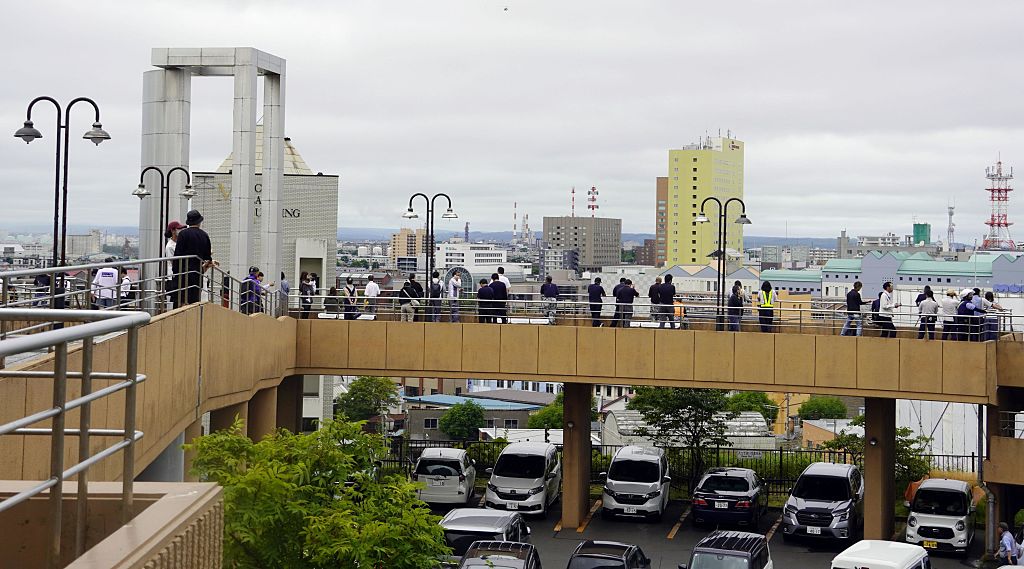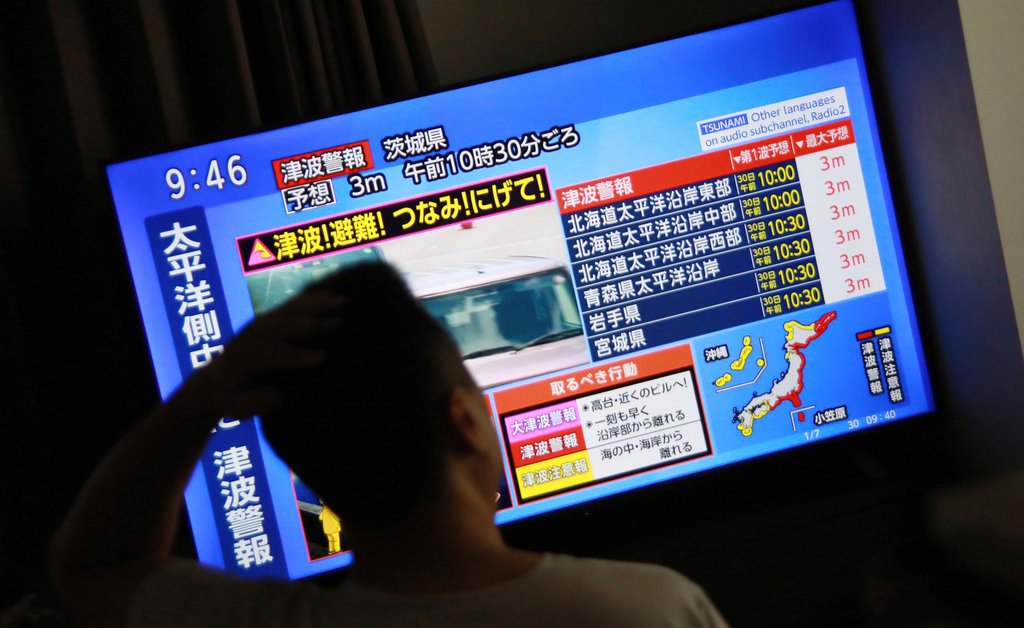The Brief July 30, 2025
Updates on tsunami warnings, NYC shooting, and more
Skip backward 15 seconds
Length:
Long
Speed:
1.0x
Skip forward 15 seconds
The sixth-strongest earthquake ever recorded has triggered waves several feet high hurtling towards coastal areas worldwide.
Countries in and around the Pacific Ocean have been placed on varying degrees of alerts for anticipated tsunamis.
While it’s still too early to fully assess how damaging the natural disaster could be, authorities have generally advised residents in at-risk areas to seek higher ground and avoid coastlines.
At least six aftershocks were recorded following the earthquake, with the magnitude of one measuring as high as 6.9.
While tsunami alerts and evacuation orders remained in effect in some parts of the world late Wednesday afternoon ET, the United States appears to be safe: Homeland Security Secretary Kristi Noem indicated that the threat of a major tsunami impacting the country has “passed completely.”
Here are the countries that have been hit so far by tsunamis since the historic quake.
Russia
In Russia, where the quake originated on Wednesday around 8:25 a.m. local time (4:25 p.m. ET, Tuesday), tsunami waves of 10-13 ft (3-4 m) hit the port town of Severo-Kurilsk in the far east coast. The town of about 2,000 people was evacuated. A tsunami threat advisory has since been lifted from the municipality.
Footage circulating online showed buildings inundated as the waves reached the coast. According to state-run news agency TASS, the mayor said three waves hit the town, with the last being the most powerful. Russia’s Ministry of Emergency Situations said on Telegram that, besides the port town, an Alaid fish processing plant was also “partially flooded.”
Kremlin spokesperson Dmitry Peskov confirmed on Wednesday that there had been no casualties in Russia as a result of the earthquake and subsequent tsunami. “All warning systems were activated promptly, and evacuation of people from the areas from which they needed to be evacuated was organized for the tsunami,” he said at a briefing.
“In general, the earthquake resistance of the buildings proved effective. Thank God, there are no casualties, and therefore, let’s say, the technological preparedness has proven itself and performed at a high level,” said Peskov.
Japan
Japan’s Meteorological Agency has downgraded all tsunami warnings in the country to advisory warnings, as of around 9 p.m. local time on Wednesday (8 a.m. ET).
Hours earlier, at 9:40 a.m. local time (8:40 p.m. ET, Tuesday), the agency issued warnings of tsunamis as high as 3 m in the country’s Pacific coast. As of 5 p.m. local time, it had observed many tsunamis along the nation’s east coast, including a wave in Kuji Port shortly before 2 p.m. (1 a.m. ET) that rose as high as 1.3 m.
Earlier, 30-cm waves struck several areas of the northern island of Hokkaido. Video shared by Reuters showed high waves reaching the island’s coastline.
There has so far been no reports of tsunami-related damages, though public broadcaster NHK reported that Tokyo authorities continue to advise people to avoid the sea. Some of the beaches in the country have also been evacuated.
JMA official Kiyomoto Masashi said, according to NHK, that a single tsunami can have a very long cycle of about one hour and tsunamis can still be observable over longer periods of time after the quake that caused them.
 People stand on a tsunami evacuation structure in Kushiro, Hokkaido, on July 30, 2025. Kyodo News/Getty ImagesEcuador
People stand on a tsunami evacuation structure in Kushiro, Hokkaido, on July 30, 2025. Kyodo News/Getty ImagesEcuador
The Galápagos Islands in Ecuador have been impacted by waves reaching as high as 1.3 meters (about 4.25 feet), according to INOCAR, the Oceanographic Institute of the Navy.
Tsunami alerts remained in effect for the area as of about noon local time Wednesday (2 p.m. ET), though the agency said that the waves hadve not caused any material damage. The elevated wave levels were expected to continue throughout the next few hours.
Peru
Peru’s national emergency center has warned that waves up to 7 feet high could reach the country’s coast. In a post just before 6 a.m. local time (7 a.m. ET) the agency said that waves between 1 meter (3.28ft) and 2.31 meters (7.58ft) were expected to reach the coastline at around 10:09 a.m local time.
Chile
SENAPRED, Chile’s disaster prevention agency, upgraded tsunami warnings to the highest level along the entirety of the country’s coast bar its three most southern territories Wednesday morning, issuing a “red alert” from the northern region of Arica and Parinacota to Los Lagos in the South, as well as Easter Island in the Pacific.
The alert for Easter Island came into effect at 6 a.m. local time (8 a.m. ET). The agency said that all local directories must begin their evacuation processes.
Precautionary alerts remained in place for the Aysén, Magallanes, and Chilean Antarctic Territory regionsEvacuations were ordered for those living in vulnerable areas along the coast. Activity in ports from Arica to San Antonio has been paused, and classes on Wednesday have been cancelled in some regions along the coastline due to the tsunami threat. At least five prisons in the country have been evacuated. .
U.S.Alaska
According to the National Weather Service, tsunami waves have been detected in the Pacific-facing side of the Alaska peninsula. Waves less than a foot high were detected in the islands of Amchitka and Adak, and are also picking up in the coastal city of Saint Paul.
California
California reported its first tsunami waves just after 1 a.m. PT (4 a.m. ET). Water levels in Crescent City, which is in Northern California near Oregon, went up to 1.5 ft, data from the National Oceanic and Atmospheric Administration (NOAA) showed.
NWS Bay Area reported that tsunami waves arrived in San Francisco around the same time, while NWS Los Angeles said that the tsunami was “making its way down the coast,” though it previously noted for Southern California residents that “widespread inundation is not expected.”
Tsunami warnings remained in place for a 40-mile stretch of coastline in northern California from the town of Klamath up to the Oregon border as of around 6 a.m. PT, according to the NWS. An advisory warning remained in place for the rest of the U.S. West Coast.
Guam
Waves up to a foot have been observed in Guam, a U.S. territory in the Pacific, according to the island’s civil defense office. More similarly tall waves are expected, though they are gradually expected to ebb in the next hours. An advisory warning remained in place for the Pacific island as of around 11 p.m. local time Wednesday (9 a.m. ET).
Hawaii
Evacuation orders in the archipelagic state of Hawaii have been lifted.
“Tsunami wave heights across the state of Hawaii are now below advisory levels and are continuing to diminish,” the Pacific Tsunami Warning Center said around 9 a.m. local time (3 p.m. ET). “Small sea level changes and strong or unusual currents may persist for several additional hours in some coastal areas.”
Hawaii was hit by waves around 7:30 p.m. HST (1:30 a.m. ET), according to NOAA data, which showed that waves as high as 5.7 ft (1.74 m) were detected in Kahului, Maui, coming in 34-minute intervals.
Gov. Josh Green said in a news conference Tuesday evening that “so far we have not seen a wave of consequence, which is a great relief to us.”
Data from the Midway Atoll sitting between Japan and Hawaii saw waves as high as 1.8 m., and Green said that waves that could hit Hawaii could be bigger or smaller than that.
There have been no reports of damage thus far, and port gates in the state have opened.


AloJapan.com